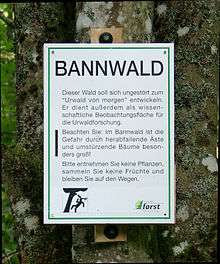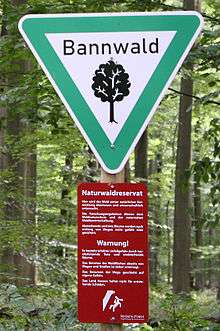Bannwald
Bannwald is a German word used in parts of Germany and Austria to designate an area of protected forest. Its precise meaning has varied by location and over time.

Etymology
The word Bannwald is a combination of Bann (English ban) and Wald (English forest or wood). Bann has many historical meanings in German, one of which refers to an area controlled by and set aside for the use of a landowner in medieval times (comparable to the forests subject to the royal ban in Anglo-Saxon England).[1] A Bannwald was a forest where a nobleman had the prerogative to make use of it and the creatures in it.[2] A royal ban forest existed at Dreieich for a very long period, and its charter was one of the most primitive.[2][3] The (obsolete) French literal equivalent bambois (also: banbois)[4][5][6] is still the toponym of local forests[7] in areas which once were part of the former Holy Roman Empire.
In modern times, the term Bannwald is, in a certain sense, an archaic word which has been revived as a specific term for forests under various types of protection.
Scope
The term is generally used with a rather broad meaning:
- Protection forest, for the protection against avalanches, rockfall, mudflow, or flooding
- Forest reserve, forest areas protected for reasons of nature conservation and environmental protection
- Recreational forest, sometimes also as recreation area
Depending on the respective forest act, there may be an overlapping or difference in meaning between the terms banned forest and protection forest.
Function
Silvicultural use is still permitted and in the case of protection forests it is even welcome (except in Baden-Württemberg). However, it is prohibited in the core zones of nature reserves. Forestal exclusion zones (temporarily restricted forest areas) subject to hunting prohibitions or restrictions, or temporary hunting grounds or game preserves (areas closed during a hunting season or breeding and upbringing season) are not classified as banned forests.
History
The term Bann dates back to the Middle Ages. At that time a Bannwald referred to a forest area where the respective territorial lord had the exclusive right to use the forest (forest privilege). Originally this applied only to hunting (hunting privilege) and fishing, however, later it was extended to the complete use of the forest. In the mountain valleys of Switzerland banned forests had the function to protect against avalanches and also to provide sufficient timber for fencing torrents. Corresponding decrees from the 14th century deal with protection against avalanches, rockfalls and flooding. The concept of Bannwald plays an important part in Ludwig Ganghofer's novel Die Martinsklause in which a tyrannical administrator in Berchtesgaden claims excessive privileges.
Countries
Germany
Baden-Württemberg
→ see also: List of Bannwälder in Baden-Württemberg
In Baden-Württemberg, there are Bannwälder Totalreservate, fully protected reserves where any use is strictly prohibited by law. In other federal states of Germany such total reserves are known under different names. Due to their structural diversity in living trees and dry wood banned forests are refugia for many endangered species of animals, plants, and mushrooms.
Bavaria
In Bavaria "forest and its existence and size is extremely essential in particular in densely populated and sparsely wooded areas and consequently its size and structure must be preserved as it is of extraordinary importance for the climate, water resources or for air purification" and may be classified as banned forest."[8]
Hessen

In Hesse a Bannwald is a forest which because of its location, size and extraordinary importance for hydrological balance, climate and air purification has to be preserved and may be cut only in exceptional cases.
Austria
In Austria, a Bannwald is a stricter form of a protection forest.[9]
Switzerland
The Swiss Forestry Act of 1874 uses the term, Schutzwald (protection forest), rather than Bannwald.
See also
- List of types of formally designated forests
- Protected forest
- Schonwald
- Wildbannforst
References
Notes
- John Mitchell Kemble (1849). The Saxons in England: A History of the English Commonwealth Till the Period of the Norman Conquest. Longman. p. 80.
- Alexander Porteous (1928). The Forest in Folklore and Mythology. Courier Dover Publications. p. 35. ISBN 978-0486420103.
- Jacob Grimm (1835). Teutonic Mythology. Nabu Press. p. 80. ISBN 978-1171888192.
- University of Lorraine: Page 9, Glossaire: Bambois, Banbois
- Henry Suter: Toponymes: Baimbo, Bambois, Banbois
- Courrendlin: Lieux-dits - Le Bambois: Forêt réservée et mise à ban
- Tous les Faits: Bambois (toponyme) Archived December 5, 2014, at the Wayback Machine
- Bavarian Forestry Act of July 22, 2005
- Article 21 et seq. of the 1975 Forestry Act.
Further reading
- Richard B. Hilf: Der Wald. Wald und Weidwerk in Geschichte und Gegenwart – First Part [Reprint]. Aula, Wiebelsheim 2003, ISBN 3-494-01331-4
- Hans Hausrath: Geschichte des deutschen Waldbaus. Von seinen Anfängen bis 1850. Publication Series of the Institute for Forestry Policy and Planning of the University of Freiburg. Published by the University, Freiburg im Breisgau 1982, ISBN 3-8107-6803-0